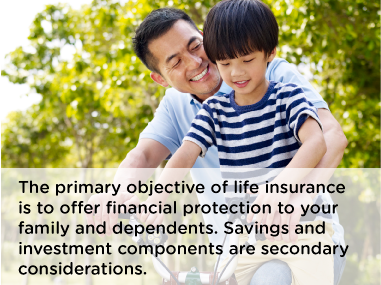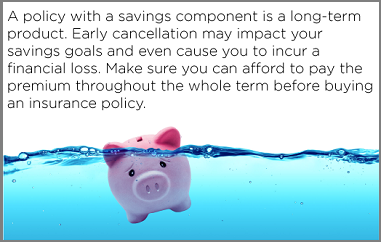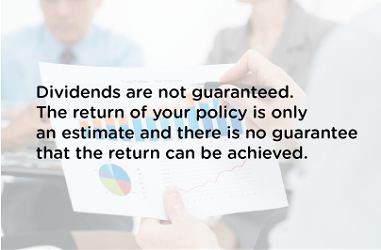Five questions to ask if you are getting the right life insurance policy
Life insurance is the most common type of insurance product in Hong Kong. But there are some who casually pick up the inexpensive policies while others may be paying thousands of dollars every month without getting adequate protection for their families. Some opt for high premium products without considering affordability, only to end up struggling with the monthly payments and resulting in policy lapses.
Consider the following questions to see whether your life insurance policy suits your needs:
1. Why are you getting life insurance?
The most important and primary purpose of life insurance is to provide financial protection to your family or dependants in the event of your death. If you have children, and need to support your partner, parents or other family members, or if you have debts (such as mortgage loans), you can consider getting life insurance. However, if you do not need to support anyone financially and you are not indebted, you probably do not need one.
If you are the main breadwinner, taking out a life insurance policy would be a good idea. Pay close attention to the life insurance components. For instance, if the product you get comes with a small protection coverage and a large savings element, the indemnity may not be enough to cover the future expenses of your family in the unfortunate event of your premature death. Therefore it is important to consider the primary reason for taking out life insurance, the cover you will be needing and affordability.

2. How much coverage do you need?
Some people may put aside 10% of their monthly salary to purchase insurance, and others may buy policies with coverage equivalent to 10 times of their annual income.
But in fact, circumstances differ from person to person, and so does life insurance coverage. You can use the Chin Family's Life Protector Coverage Calculator to calculate the coverage based on your actual circumstances.
3. Which type of life insurance policy do you need?
There are three common types of life insurance products, namely term life policy, whole life policy and endowment policy. They have different features to fit various insurance objectives.
| Term life policy | Whole life policy | Endowment | |
|---|---|---|---|
| Coverage period | In general, a fixed period, e.g. 10 or 20 years. | Whole life, e.g. up until 100 years old. | A specific period as stated in the policy, e.g. 10 years. |
| Death benefits (for the same amount of premium) | High | Lower than a term life policy. | Lower than term life and whole life policies. |
| Premium | Gradually increases with age; younger people pay a lower premium, but this may increase significantly as you get older. | Level premium for the whole premium paying period (however some insurers retain the right to adjust premium). The principle is to average the higher premium of the senior years to the lower premium at the early life stage. Some policies requires the policy owners to pay the premium for the whole life. | High |
| Savings component | None | Yes, but only becomes evident after a long period of time. | Higher savings, provided that the policy is maintained until maturity. |
| Features | The policy can be renewed upon expiry. | Part of the return depends on non-guaranteed dividends (some endowment policies offer guaranteed dividends). If a policy is cancelled in the short or medium term, a rather big loss may occur. The value of the policy can be used as collateral for a loan, but you have to pay interest. You can add riders (e.g. medical, critical illnesses, personal accident etc.) to the whole life or endowment policies. | |
| Suitable for | Younger adults and those who need bigger coverage, e.g. for repaying mortgages and supporting dependents, etc. | Those need to be covered for a longer period, or can afford to pay a higher premium, and wish to have a policy with a savings component. | Those whose main objective is to save money. |
In the perfect world, the ideal life insurance product is one that can be bought inexpensively for a high coverage alongside good return. Yet, in reality, life insurance products are only favourable in terms of the premium, the coverage or the savings function. In other words, the lower the premium, the smaller the coverage and the savings element in general, and vice versa.
- A term life policy can be bought with a lower premium for a bigger sum insured. Yet, the premium may increase significantly as you get older, making it less affordable. Also, there is no savings element.
- Whole life insurance helps you to save in the long run. You are charged a level lifetime premium, but the available coverage is relatively low (considering the more expensive premium), and may not be able to match your actual needs if you require more coverage. Those who would like to use “premium offset option” should take notes of the relevant risks (see below for details).
- An endowment policy can provide more savings. It generally comes with a higher premium and smaller coverage as compared with whole life policies, and thus endowment policy may not provide adequate death benefits. If your objective is long-term savings instead of death benefits, an endowment policy may be an option. Note that part of the premium from the endowment policy is used to pay for the life insurance. As such, if you do not need life protection, you can consider other savings options or investment tools.
Different life stages mean different insurance needs. If you require bigger coverage but are constrained by budget, you may consider the lower premium term life that offers a bigger coverage. Alternatively, consider using both term life and whole life policies, e.g. take out a whole life policy with lower coverage but a premium that you can afford as the basic protection, and then add a term life with bigger coverage (either as a rider or a new policy) to achieve the objective of offering protection to your family at different life stages.

4. What are guaranteed cash and dividends?
The value of a life insurance policy with a savings component comprises of two parts, i.e. guaranteed (also known as "guaranteed cash value") and non-guaranteed (the "dividends"). When an insurance intermediary recommends a life insurance policy with a savings component, an illustration summary of benefits of the life insurance policy should also be provided. This summary lists out the guaranteed cash value, projected dividends, death benefits and total premium at the end of each policy year.
The guaranteed cash value refers to the guaranteed value as specified in the insurance agreement. Dividends are the distributable surplus that the insurance company decides to give out; they are announced annually, but there is no guarantee that the dividends will be paid or how much will be paid. The amount of distributable surplus is mainly based on the actual investment return of the insurance company, claims amounts and general expenses. Therefore, the dividend amount is not guaranteed and it changes according to the company policy. The actual distributed dividend may be higher or lower than the projected amount at the time the policy is issued.
How to interpret the return of life insurance policy
After paying premiums for a long period of time (e.g. 15 years), the accumulated guaranteed cash value plus the dividends may exceed the premium that you paid. Different policies have different guaranteed cash value, projected dividends and interest rates. As such, the calculated projected returns are also different. If a higher dividend and interest rate are used for the calculations, the projected return may seem to be very attractive; but you must be aware that the number is only an estimate based on a number of assumptions. In other words, the return is only a projection and there is no guarantee that it can be achieved. If you cancel the policy in the short term (or even mid-term), you will not only fail to achieve the purpose of saving and you may not be able to recover the full amount that you have paid.
What to note for "premium offset option"
Some whole life policies may offer premium offset option, i.e. after premiums have been paid for a number of years, further annual premiums may be paid by the dividends. But as dividends are not guaranteed, premium offsets cannot be guaranteed either. Also, since dividends have been used for paying premiums, the accumulated dividends will be reduced and may not be sufficient to offset premium in the future, i.e. you may need to pay premium again.
An endowment policy has to be held until maturity
The policy holder must hold an endowment policy until maturity, otherwise a loss will be incurred. Certain endowment policies only require the holder to pay premiums in the first few years, e.g. for an 8-year policy, the holder only needs to pay in the first three years but not the remaining five. However, the policy holder must maintain the policy until the agreed date (in this case, the full eight years). Early cancelation would result in a loss. The amount that can be recovered depends on the value of the policy at that time, i.e. how much guaranteed cash value and dividends have been accumulated.

5. Have you reviewed your life insurance plans regularly?
As you step into different life stages – getting married, having children, buying a home, or being promoted – you would have different financial responsibilities. The sum insured by your previously-purchased policy may no longer be adequate. On the other hand, as you age, the coverage you need may be reduced when you are retired, your children have finished school or you have paid up your mortgage. Also, inflation is another factor that we have to consider. For these reasons, you should regularly review your life insurance needs.
Prior to taking out a new insurance policy, topping-up on your existing plan or replace it with a new policy, you should do your research and gather information from the websites of different insurance companies. You can also consult with different intermediaries to compare the features of different products.
When you compare the terms of the policies and the premium amount, make sure you are making an apple to apple comparison. Comparing the premiums alone may not be a wise choice as the policy with the lowest premium does not necessarily offer the most suitable cover for your needs. Similarly, pay attention to the projected return of the policy, which is only an estimate instead of a guaranteed return. Your insurance intermediary should explain the details of the policy to you. If you do not understand, you should ask the intermediary to explain clearly. You should read the policy document to make sure you understand all the terms and conditions of the policy that you are buying. You should keep a copy of the signed policy and the offering/marketing documents provided by the intermediary. An insurance policy is a legal document. If there are any conflicts regarding the policy in the future, the documents that you have signed will be treated as evidence.
Policyholders of new life insurance policies can cancel the policy and obtain a refund during the cooling-off period. The cooling-off period is 21 days after the delivery of a life insurance policy or issue of a notice to you or your representative, whichever is earlier.




